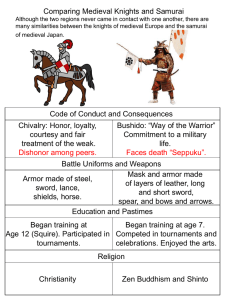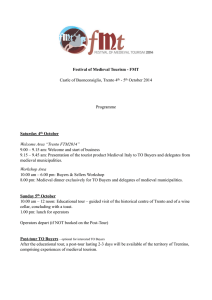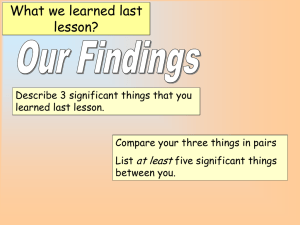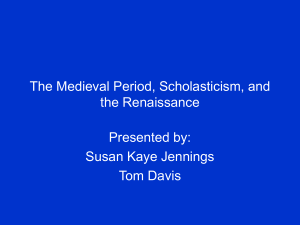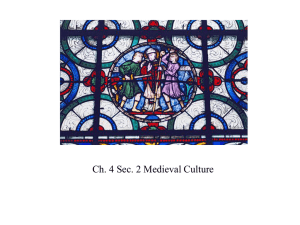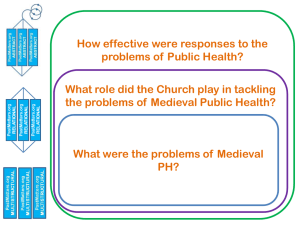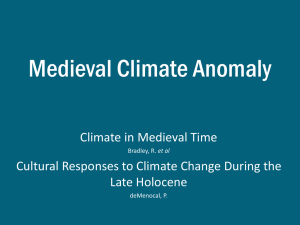Chapters 5 to 7
advertisement
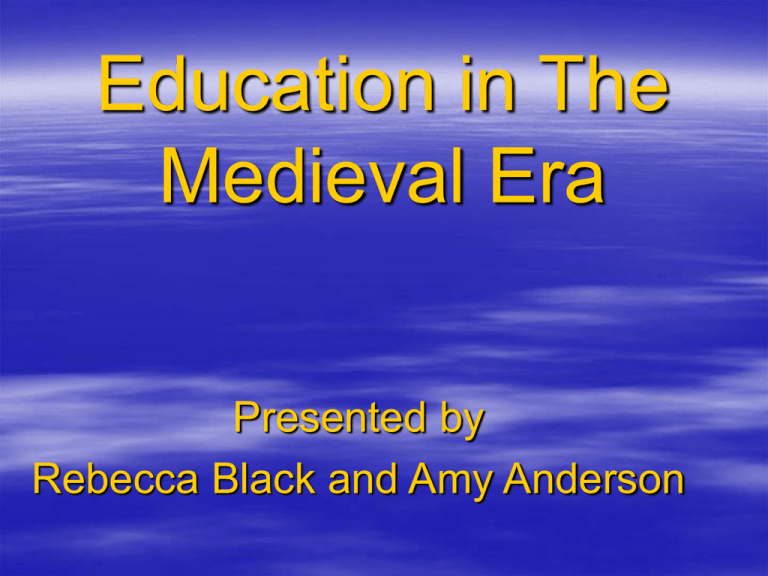
Education in The Medieval Era Presented by Rebecca Black and Amy Anderson Imagine a time of lords and ladies, immense castles, and brave knights. Imagine a era when land owners worked diligently to cultivate the fields and knights served the Feudal lord to protect the land. Imagine a time when the main educational agency was the church where divinely sanctioned teaching rested on scripture and doctrine. Fountains Abbey, England Imagine a time when reality was viewed as unchanging and stable without regard to working toward a better future – a time when all looked toward a better future as promised by the church. Imagine yourself in the medieval era Ludlow Castle, England Medieval Times Religious values well defined Political, Social and Economic valuesfragmented Education managed and maintained by the church Three Types of Educational Institutions Clergy Preparation Chivalric Training Craft and Vocational Education Three leveled system corresponding to the class structure – specific education for cleric, knights, and craftsmen Serfs The largest group of the population- a permanently indentured agricultural class remained largely unschooled Learning occurred as the observed their parents using the skills needed to survive Church Related Schools Access to education limited Early in medieval era abbeys were directed to provided some education to “capable boys” Male dominated Directed at preparing priests and other clerics Mont-Saint Michel, France Church Related Schools Four types of church related schools provided basic or elementary education – Parish – Chantry – Monastic – Cathedral Parish Schools A congregation served by a priest Provided elementary education – Religious rituals – Music needed for the celebration of Mass – Secondarily : reading, writing and music Chantry Schools Supported by an endowment Trained boys in Latin so that they could chant the responses needed in celebrating the liturgy Monastic Schools Trained monks either as priests or brothers – Church doctrine – Community regula – Reading, Latin, simple arithmetic, and religious doctrine – Monasteries were literary, artistic and intellectual centers Nunneries/ Convents Religious and educational formation for future nuns Usually beginning around the age of 7 Some girls returned to the secular world after completing their studies – Latin, singing, religious doctrine, embroidery, spinning and weaving, painting Cathedral Schools Result of the decline of monastic schools stimulated by the revival of the cities Required of each Bishop’s church to maintain a school to educate priests, clerics and the poor Offered both elementary and secondary education General or liberal studies Occasionally reading and writing in Latin Medieval Places of Learning Castles Monasteries & Priories Cathedrals & Ministers Parish Churches Other www.pitt.edu/~medart/ Chivalric Education Early – Between the ages of 7 and 15 – Serve at the court of his father’s lord – Practiced manners and gestures of court life – Learned how to be a gentleman – Sing and play a musical instrument -maybe learned to read and write a vernacular language Chivalric Education Squire – Age 14 – 21 – Served as an attendant for the lord of the castle or one of the knights of the court – Professional skills of knighthood Hunting, warfare, care of armor, arms and horse - Cultural Aspects of knighthood singing, recitation, composing verse, exaggerated politeness, dancing, story telling, chivalric symbols, coats of arms Chivalric Education Knighthood –Age 21 –Inducted by an overlord and church officials -Dedicated to serving his lords Vocational and Craftsman Education Not formal schools but well defined – Apprentice – Journeyman – Master Craftsman Role of the Master Apprentice teach trade look after morals/religion provide food, lodging and a small stipend Maybe teach reading and writing work diligently keep craft secrets obedient to the Master Medieval Universities Historical Setting – Social – Political Medieval Universities Organization – Student Centered vs. Faculty Centered – At first, no permanent campus Medieval Universities Curriculum – Specialties – Degrees – Educational Philosophies Medieval Universities Links to Modern Times – Similarities – Differences The Renaissance Transition from medieval to modern Revival of commerce and city life Decline of the Roman Catholic Church Shift in education mirrors political shift The Renaissance and Education Humanistic Educational Philosophy aimed at producing the well-rounded, liberally educated person – Classical Greek and Latin literatures led to a cultured person – Style of writing could lead to elegance of style and expression The Renaissance and Education Women’s Education – Women of upper socioeconomic classes enjoyed more educational advantages Provided by convent schools, tutors, or classical humanist court schools – Upper class families employed resident tutors Instruction provided to both boys and girls – Large numbers of women remained uneducated References About.com. History of the medieval child. Accessed 11 September 2006. Available from http://historymedren.about.com/library/weekly/aa0 33001b.htm References California State University at Pomona. The Educational Legacy of Medieval and Renaissance Traditions. Database online. Accessed 11 September 2006. Available from http://www.csupomona.edu/~plin/ls201/medren ais_home.html. Cambridge University. Speaking Volumes: The Medieval Library. Accessed 11 September 2006. Available from http://www.lib.cam.ac.uk/exhibitions/volumes/ medieval.html. References Cambridge University. A Brief History: The Medieval University. Accessed 11 September 2006. Available from http://www.cam.ac.uk/cambuniv/pubs/history/ medieval.html. Education of medieval women. Accessed 11 September 2006. Available from http://www.csupomona.edu/!plin/ls201/medieval3.h tml References Dartford Town Archive. Educational provision in medieval Dartford. Accessed 11 September 2006. Available from http://www.darfordarchive.org.uk/medieval/ education.shtml Gutek, G.L. (1995). A history of the western educational experience. Prospect Heights, Illinois. References Medieval-Life.net. (2000). Medieval education. Accessed 11 September 2006. Available from http://www.medieval-life.net/education.htm Ross, D. & Britain Express.com. Medieval schools and universities. Access 11 September 2006. Available from http://www.britainexpress.com/History/Medieval_ Schools_and_Universities.htm References Sullivan, Eugene. An Academic Costume Code and An Academic Ceremony Guide. Accessed 11 September 2006. Available from http://www.acenet.edu/AM/Template.cfm?Secti on=Frequently_Asked_Questions3&Template=/ CM/HTMLDisplay.cfm&ContentID=8086#Histori cal. Trueman,C. Medieval Education. Accessed 11 Septemeber 2006. Available from http://www.historylearningsite.co.uk/medieval_edu cation.htm Music Credits The ensemble of old church music "Sreteniye". Ancient church singing of Bysantine, Georgia and Rus English Renaissance Music by La Primavera. Published by Magnatune



